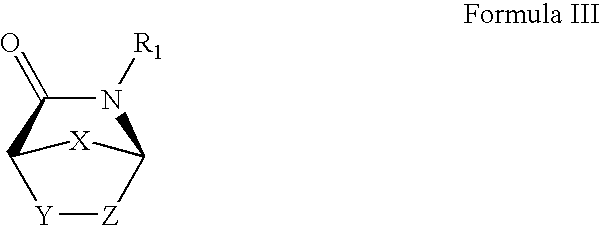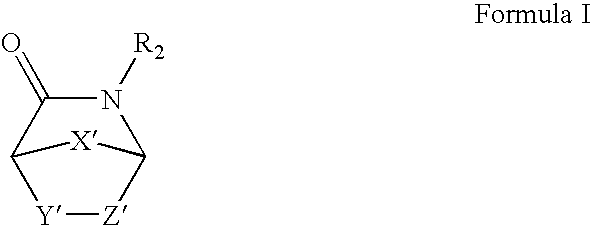Process for the preparation of optically active azabicyclo heptanone derivatives
a technology of azabicyclo heptanone and heptanone, which is applied in the field of process for the preparation of optically active azabicyclo heptanone derivatives, can solve the problems of poor yield, difficult to perform, and tedious conversion of optically active n-acetyl-lactam to (+)/(-) lactam, and achieves the effect of convenient and fast conversion
- Summary
- Abstract
- Description
- Claims
- Application Information
AI Technical Summary
Benefits of technology
Problems solved by technology
Method used
Image
Examples
example 2
The general procedure for the enantioselectsive hydrolysis of (.+-.)-2-azabicyclo(2,2,1)hept-5-en-3-one, (Vince's lactam) (1) is as follows:
0.1 g (0.00092 mole parts) of (.+-.)-2-azabicyclo[2,2,1]-hept-5-en-3-one (1) was suspended in phosphate buffer (5 parts) and 50 mg of the wet biomass of culture (ATCC No.21285) was added. The mixture was kept stirring for 72 hr. The cell mass was removed by filtering through celite and the filtrate was extracted with dichloromethane (5.times.10 parts). Removal of the solvent gave optically active Formula III in 31.8% chemical yield, and 58.2% ee.
example 3
The general procedure for the enantioselective hydrolysis of (.+-.)-2-azabicyclo(2,2,1)hept-5-en-3-one, using the cell mass obtained from culture (ATCC No.21285) was followed. 0.1 g (0.00092 mole parts) of the (.+-.) racemic mixture was suspended in phosphate buffer (5 parts) and an amount of the cell mass as indicated in Table 1 was added. The mixture was kept stirring for 24 hrs. The cell mass was then removed by filtering through celite and the filtrate was extracted with dichloromethane (5.times.10 parts). Removal of the solvent gave optically active Formula III. The results are summarized in Table 1.
example 4
The general procedure for enantioselective hydrolysis of (.+-.)2-azabicyclo(2,2,1)hept-5-en-3-one, using the cell mass from culture (ATCC No.21285) was followed. 0.2 g (0.00184 mole parts) of (.+-.) was suspended in phosphate buffer and an organic solvent,(as indicated in Table 2) 10 parts. 0.1 gm of wet cell mass was added and kept stirring 24 hrs. The cell mass was removed by filtering through celite and the filtrate was extracted with dichloromethane (5.times.10 parts). Removal of the solvent gave optically active Formula III. The results are summarized in Table 2.
The ratio of phosphate buffer (0.2M, pH 7.4) to organic solvent is (9:1).
PUM
 Login to View More
Login to View More Abstract
Description
Claims
Application Information
 Login to View More
Login to View More - R&D
- Intellectual Property
- Life Sciences
- Materials
- Tech Scout
- Unparalleled Data Quality
- Higher Quality Content
- 60% Fewer Hallucinations
Browse by: Latest US Patents, China's latest patents, Technical Efficacy Thesaurus, Application Domain, Technology Topic, Popular Technical Reports.
© 2025 PatSnap. All rights reserved.Legal|Privacy policy|Modern Slavery Act Transparency Statement|Sitemap|About US| Contact US: help@patsnap.com



